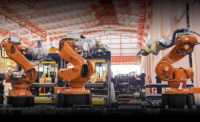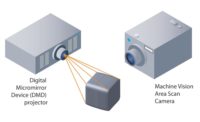According to Hollywood script writers, robots are either secretly intent on overthrowing humanity or they’re beeping, blinking, and buzzing sidekicks that provide comedic relief. In reality, state-of-the art robots are profoundly changing how work gets done.
TECH TIPSImaging system design plays a significant role in helping manufacturers deliver smaller, more efficient, and less expensive robots for a widening range of applications. Video interfaces for the first robotic imaging systems were often based on custom designs that met performance requirements but posed cost challenges. Even today, manufacturers often underestimate the time and knowledge required to develop a video interface for real-time, high-resolution image transfer. |
Initially, robots liberated workers from highly repetitive, often dangerous tasks that required speed and strength but little precision, such as welding and painting cars on an assembly line. Today, technology advances are driving the design of robots that automate highly complex tasks with unmatched speed, strength, and flexibility. In critical applications where humans may suffer from fatigue or distraction, such as surgery, image-guided robotics augment our capabilities with new levels of precision and accuracy.
According to industry reports, global spending on robots is expected to reach about $67 billion by 2025. To help make this estimate a reality, manufacturers are now actively seeking new solutions that can help further boost performance and lower costs. These factors are particularly important in military, medical, and consumer markets, where the initial sticker price and long-term operating expenses significantly influence buying decisions.
Considering these challenges, imaging system design plays a significant role in helping manufacturers deliver smaller, more efficient, and less expensive robots for a widening range of applications.
Making the Video Connection
The star of the machine vision trade show floor is almost always a multi-armed robot that wows the crowd by quickly sorting nuts from bolts speeding by on a conveyor belt. It’s an impressive feat, certainly beyond human capability. But what’s often overlooked is the behind-the-scenes video connection that’s driving the performance.
Hidden by the blur of the robotic arm, hardware and software components that comprise the video interface must transfer high-resolution images from cameras or image sensors to computers used for processing and analysis in real-time, and with low, consistent latency (or delay). A bin picking robot, for example, requires instantaneous transfer of imaging data from a camera to a processor to precisely locate and choose the right products from the speeding conveyor belt. Within milliseconds, the image system must detect an object, model it and the surrounding environment, accurately select the part, and then plan its next path.
Video interfaces for the first robotic imaging systems were often based on custom designs that met performance requirements but posed cost challenges. Even today, manufacturers often underestimate the time and knowledge required to develop a video interface for real-time, high-resolution image transfer. Proprietary designs also sidetracks internal R&D resources from more valuable core projects, while introducing integration challenges in multi-vendor systems.
Camera Link, introduced in 2000 as the first standard developed specifically for machine vision, was also used in robotics. While Camera Link video interfaces provide the bandwidth required for high-resolution sensors and fast frame rates, the tradeoff in their use is complexity and cost. Each camera or sensor requires a PCIe frame grabber at the computing endpoint to capture data, plus a discrete power supply. In addition, Camera Link cabling is expensive, heavy, and difficult to manage.
Recognizing limitations posed by custom or legacy products, robotic manufacturers are now migrating to GigE Vision and USB3 Vision standard-compliant video interfaces to help deliver both performance and cost advantages.
Computing and Cabling Benefits of GigE Vision
With GigE Vision interfaces, imaging data is transmitted directly to the Ethernet port on a computing platform. There is no need for a PCIe frame grabber. This means video can be transmitted to any type of computer, enabling the use of lower-cost, smaller form factor laptops, tablets, single-board computers, and embedded platforms for processing and analysis.
With the long reach of GigE cables—up to 100 meters over standard Cat 5/6 copper cabling and thousands of meters over fiber versus just 10 meters for Camera Link—processing and analysis equipment can be located outside of harsh operating environments.
Designers can take advantage of Ethernet’s networking flexibility to build real-time switched video networks supporting almost every conceivable connectivity configuration, including point-to-point, point-to-multipoint, multipoint-to-multipoint, and multichannel aggregation. Ethernet also offers superior scalability, supporting meshed network configurations that easily accommodate different data rates and the addition of new processing nodes, displays, and switches.
These performance and cost advantages that have established GigE Vision as the most widely deployed video interface standard for machine vision applications are easily translated to robotic design. In an intelligent robotic arm, manufacturers can take advantage of longer reach Ethernet cabling to move expensive processing platforms from a dirty, dusty manufacturing floor to a safer centralized operations center. Power over Ethernet (PoE) enables “one-cable” installations to simplify deployment by freeing systems from hard-wired power requirements for cameras.
The multicasting capabilities of GigE Vision also enable more flexible system design, allowing designers to employ lower cost distributed processing rather than requiring a computer for each specific task. If the primary computer is taken offline for maintenance or live testing of new image processing algorithms, inspection functions can be assumed by backup computers without the need to switch cables or change software settings. Depending on application requirements, the networked video can be easily distributed to multiple displays, to users in different locations, combined with other image feeds, and sent to remote recording units.
For existing deployments, robotics manufacturers can employ GigE and 10 GigE external frame grabbers that convert video from existing cameras and image sources into a GigE Vision-compliant image stream. In new designs, embedded hardware solutions allow manufacturers to easily and more cost-effectively integrate GigE Vision connectivity into cameras. This includes new GigE Vision over IEEE 802.11 wireless video interface solutions that support untethered imaging solutions.
Embedded Processing Advantages of USB3
Building on concepts successfully developed for GigE Vision, with USB3 Vision data is transmitted directly to an existing port on a computer with sustained throughput approaching 3 Gb/s. This surpasses the performance of Camera Link Base configurations, and rivals Medium configurations, without requiring multiple cables or a PCIe frame grabber to capture data. By eliminating the need for frame grabber cards, robotics designers can employ smaller form factor, lower cost embedded and single-board processors.
USB3 Vision video interfaces also deliver advantages beyond raw speed and computing support to help lower costs and boost performance. The flexible, lighter “plug-and-play” USB cables cost less and are simpler to install than the bulky cabling and connectors of legacy interfaces. Video, control data, and power is transmitted over a single cable, thus reducing cabling complexity and eliminating the need for an external power supply for cameras.
One fast growing opportunity for USB3 Vision video interfaces is service robots, including medical telepresence systems that allow remote healthcare specialists to provide hospital- and home-based patient care. These devices require instantaneous transfer of imaging data from a camera to a processor to precisely navigate, while the visual, auditory, and tactical technologies must all work together at near-zero latency to reproduce a level of care that rivals an in-person visit.
With USB3 Vision video interfaces, manufacturers can simplify the design and reduce the cost, weight, and power consumption of service robots by employing a small form factor computing platform for processing and analysis.
In a service robot, external frame grabbers convert images from Sony Block cameras used for inspection and navigation into USB3 Vision-compliant video streams. Alternatively, with embedded video Interface hardware, camera manufacturers can integrate USB 3.0 video connectivity directly into their products.
Video is then transmitted over high-bandwidth, flexible, low-cost USB cables directly to ports on an integrated single-board computing platform. By eliminating PCIe frame grabbers within the robot, designers can reduce system complexity, component count, and costs. In addition, decreasing the weight and power consumption of the robot extends battery life, translating into more patient visits between charges.
Performance and Cost Advantages
Robots are being used in a widening range of applications, with businesses recognizing that their speed, strength, and unwavering stamina can significantly help reduce expenses and improve performance and productivity. Increasingly, robots are manufacturing the products we consume, harvesting and packaging the food we eat, and caring for the sick.
To help drive the continuing advancement of robots into new markets, manufacturers are under pressure to deliver lower cost solutions that deliver higher levels of performance. Choosing the right video interface is a key step in meeting these challenges.



